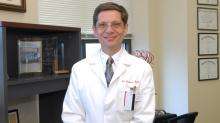Joseph Broderick, MD
(PhysOrg.com) -- An international study led by University of Cincinnati (UC) researchers has detected two genetic variations that could provide insight into why intracranial aneurysms develop.
Joseph Broderick, MD, chair of UC’s neurology department, is the principal investigator for the Familial Intracranial Aneurysm (FIA) study, a collaborative research effort of investigators throughout the United States, Canada, Australia and New Zealand. Sponsored by the National Institutes of Health, the study is examining genetic and other environmental risk factors for intracranial aneurysm.
The study’s findings will be presented at the American Academy of Neurology (AAN) 2009 annual meeting April 25-May 2 in Seattle by Dan Koller, PhD, of Indiana University, the statistical genetics center for the study.
Intracranial aneurysms are “blisters” which form within the arteries of the brain. A rupture of an aneurysm may lead to subarachnoid hemorrhage, which occurs in about 20,000 people annually in the United States with 35 percent dying within the first 30 days. Most of the deaths from subarachnoid hemorrhage are due to rapid and massive brain injury from the initial bleeding, so prevention of aneurysm formation is important.
Identification of susceptible genes in the formation and rupture of intracranial aneurysms would help researchers understand how aneurysms develop and could lead to the development of improved screening, diagnosis and prevention.
In the study, 391 familial intracranial aneurysm cases selected from population-based studies in the Greater Cincinnati region were compared with 402 unrelated control cases. Significant association with intracranial aneurysm was observed for two genes, COL9A1 (type IX collagen) and PDE1A (phosphodiesterase 1A).
“Collagen is a common substance in our body that is important in blood vessels,” Broderick says. “And the phosphodiesterase gene affects the function of the arterial wall. So both are biologically very plausible genes as to why aneurysms develop and rupture. In addition, the variants that we found are relatively common in the population.”
The next step, Broderick says, is to replicate the study’s findings in another group of aneurysm cases and controls.
Provided by University of Cincinnati (news : web)


















